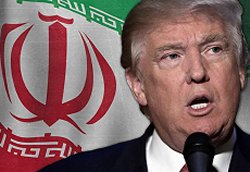
|
- Iran: Eight Prisoners Hanged on Drug Charges
- Daughter of late Iranian president jailed for ‘spreading lies’ - IRAN: Annual report on the death penalty 2016 - Taheri Facing the Death Penalty Again - Dedicated team seeking return of missing agent in Iran - Iran Arrests 2, Seizes Bibles During Catholic Crackdown
- Trump to welcome Netanyahu as Palestinians fear U.S. shift
- Details of Iran nuclear deal still secret as US-Tehran relations unravel - Will Trump's Next Iran Sanctions Target China's Banks? - Don’t ‘tear up’ the Iran deal. Let it fail on its own. - Iran Has Changed, But For The Worse - Iran nuclear deal ‘on life support,’ Priebus says
- Female Activist Criticizes Rouhani’s Failure to Protect Citizens
- Iran’s 1st female bodybuilder tells her story - Iranian lady becomes a Dollar Millionaire on Valentine’s Day - Two women arrested after being filmed riding motorbike in Iran - 43,000 Cases of Child Marriage in Iran - Woman Investigating Clinton Foundation Child Trafficking KILLED!
- Senior Senators, ex-US officials urge firm policy on Iran
- In backing Syria's Assad, Russia looks to outdo Iran - Six out of 10 People in France ‘Don’t Feel Safe Anywhere’ - The liberal narrative is in denial about Iran - Netanyahu urges Putin to block Iranian power corridor - Iran Poses ‘Greatest Long Term Threat’ To Mid-East Security |
Thursday 14 February 2008Iran feeding uranium gas into centrifuges: diplomatVIENNA (AFP) — Iran has started feeding small amounts of uranium gas into advanced centrifuges, in what could be an important step towards mastering the technology used to make both nuclear energy and atomic bomb material, diplomats said Thursday. "They began a few weeks ago. The amount of gas is very small and it's only a small number of centrifuges," a Western diplomat told AFP on condition of anonymity. "But it's proof that they've now completed the technical testing and are now proceeding on to the next stage in the process towards (uranium) enrichment." It emerged last week that Iran has begun tests of the so-called P2 or second-generation centrifuges, which are more efficient than the P1 or first-generation machines used until now at Iran's nuclear facility in Natanz. The initial P2 tests had been dry-runs, without the uranium UF6 gas needed for enrichment. But now testing has begun with tiny amounts of gas, diplomats said, underlining Iran's determination to press ahead with uranium enrichment, flying in the face of repeated resolutions by both the UN Security Council and the International Atomic Energy Agency (IAEA), which say Tehran must do so to resolve a long-running stand-off. "The United Nations and the IAEA have made clear that confidence can only be restored through full suspension and ratification and implementation of the Additional Protocol," which allows snap inspections of Iran's nuclear facilities, said an EU diplomat. "In such circumstances, it is quite extraordinary to hear suggestions that Iran is developing new centrifuges," the diplomat added. "Once again, they're thumbing their noses at the rest of the world. They're serious about developing the new centrifuges," another diplomat said. Western nations, led by the United States, accuse Iran of seeking to develop the atomic bomb, a charge which Tehran rejects, insisting that its nuclear activities are entirely peaceful. The enrichment issue is at the crux of the four-year nuclear crisis between the Western powers and Iran. Enriched uranium can be used to make nuclear energy but also the fissile material for an atomic bomb. Western nations argue Iran does not need its own enrichment facilities because the nuclear power plant being built at Bushehr will run on fuel supplied by Russia. But Tehran insists it has an inalienable right to develop nuclear power. The UN Security Council has already slapped two rounds of sanctions on the Islamic republic, and the United States and European countries are keen for a third set in face of Iran's continued defiance on the enrichment issue. A final decision is likely to hinge on a new report by IAEA chief Mohammed ElBaradei, scheduled for release later this month. Last year, IAEA inspectors confirmed Iran's claim that it had 3,000 P1 centrifuges up and running at its Natanz nuclear facility, which is the amount needed, in ideal conditions, to produce enough material in one year to make a single atom bomb. Nevertheless, the P1 centrifuges were currently estimated to be running at only 10 percent capacity. Experts say that P2 second-generation centrifuges produce 2.5 times more enriched uranium than P1 centrifuges. But because foreign-made parts are difficult to come by given the trade embargo in place against the Islamic republic, Iran has had to design and build its own modified version. Some experts believe that since Iran has so far failed to overcome the technical difficulties dogging the P1 centrifuges, it has little chance of getting the P2 machines fully up and running any time soon. "It's a structured learning curve. You've got to do the P1s first," said Simon Henderson, a director at the Washington Institute. "Until the P1s work properly, it won't be possible for the P2s to work properly," he said. Nevertheless, Henderson suggested that Iran might be in a position to build a bomb a lot sooner than many people thought. "The timeline is not as generous as some people say it is, nor as the NIE (the recent US intelligence report) suggested it might be. It could be a matter of just one or two years," Henderson said. The National Intelligence Estimate, published to great furore last year, found that Iran had had a covert nuclear weapons programme, but had abandoned it in 2003. The report suggested that US allegations about Iran's atomic goals had been exaggerated, although it said Tehran could still have the capability to make a nuclear weapon by 2015. |

 Send to a Friend
Send to a Friend
